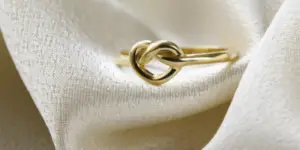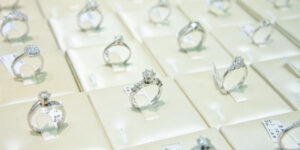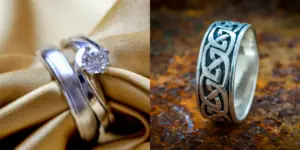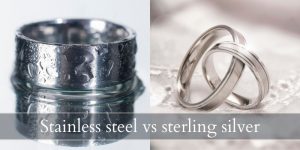Rose gold has seen an immense surge in popularity in the past two decades. This is by no means a new type of gold, rather its popularity has waxed and waned as time went by. So, rose gold has slipped in and out of fashion ever since the late 1800. Today, it is very much in, especially when paired with a diamond or morganite stone.
So you may be wondering if your new favorite piece of rose gold jewelry will tarnish, or leave a green mark on your finger. And whether rose gold goes with any other metal or metal color, and what gems may be set in rose gold. You’ll be surprised by how amazingly versatile rose gold actually is. But first let’s find out if it loses its color !
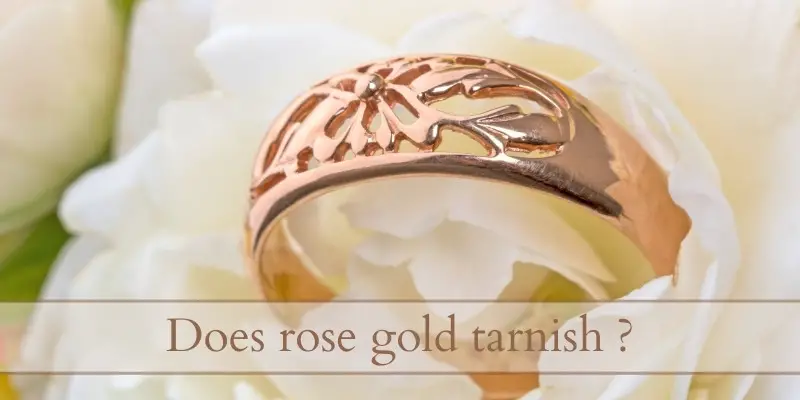
Does rose gold tarnish ?
No, rose gold does not tarnish by turning black like silver. Neither the gold nor the copper in rose gold tarnish black. But the copper in rose gold may turn a little darker after a few decades. This is the only way rose gold may change its color.
Higher karat rose gold – 18k and up – has more pure gold than copper, which leads to a much better color resistance in time. A 14k rose gold ring will lose its shine and get a bit darker faster than an 18k rose gold ring. Both will happen very slowly, but there is still a difference because the gold in both rings is completely resistant to tarnish.
Is rose gold real gold ?
Yes, rose gold is real gold, as it is a gold alloy like any other on the market. Rose gold is an alloy of pure yellow gold, silver, and copper. Higher karat gold has more pure gold and less copper, while lower karat gold has more copper and less gold. Rose gold may also contain a bit of silver, which brightens the overall color of the gold alloy.
Not all brands offer the exact same percentage when it comes to rose gold. This means if you want to know the specific percentage of copper or silver in your rose gold jewelry, you need to ask the seller or jeweler you bought from. As a result, you might see that one brand’s 14k rose gold is lighter in color than another’s 14k rose gold, and other such differences.
Read also: Fancy Cut Diamonds Explained
The reason you see gold alloyed with copper is because pure yellow gold is far too soft to be used for anything. In truth 24k gold cannot be used for anything than currency. Any piece of jewelry made from pure gold will break and bend out of shape easily. Copper is a far tougher metal, and mixing gold with copper leads to a much stronger piece of gold.
Does rose gold go with silver ?
Yes, rose gold does go with silver because its peachy-pink hues go very well with neutral colors. This means you can safely wear rose gold with silver, white gold, platinum, and any other silvery-white metal.
If you’re bold you may wear rose gold combined with yellow gold, but making them compliment each other instead of competing will be difficult. This combination works best if one of the golds – rose or yellow – is noticeably darker than the other.
Does rose gold turn your finger green ?
Rose gold might turn your finger green due to the copper in it. Not everyone may go through this, but it is a chemical reaction between the sweat and oils on your skin and the copper atoms in the rose gold. Higher karat rose gold has less copper in it, so it ahs a lower chance of turning green.
Again, remember that not everyone has this reaction. But if you do know your skin turns green when in contact with copper for several hours, then rose gold might not be for you.
What does rose gold go with ?
Wondering what stone to pair with rose gold ? If you’re set on this particular type of gold you have quite a few options. It’s just as versatile as yellow gold, though you might find that not every color work that great with rose gold.
We’ve compiled a list of color and gems that go great with rose gold, and we hope you find a gemstone that you truly love here. Keep in mind that we’ve selected gems that are safe to wear daily, so they have a Mohs rating of at least 7.5. You won’t find pearl or opal on this list, as they are soft gemstones.
White – diamonds, moissanite, white sapphire
White gems, or perfectly clear ones, are the go-to gemstone when it comes to rose gold. There has been an immense trend of 18k rose gold engagement rings with a simple diamond as a center stone. Or halo rings, or eternity rings, or three stone rings, anything that involves rose gold and white diamonds.
This is a beautiful sparkly combination that speaks to your feminine side. And since most engagement rings are worn by women, a rose gold and diamond engagement ring was of course going to soar in popularity.
If you find you can’t afford a diamond – it is the most expensive gem – or would simply like a more accessible stone for an everyday ring, then you may want to look at moissanite or cubic zirconia. Both are diamond simulants that offer a very night display of both brilliance and fire.
White sapphire is a great choice if you’re looking for a clear or white stone, but it simply cannot offer the same brightness as a diamond, moissanite, or CZ. Sapphires have a lower refractive index (1.75) which means they simply cannot offer as much fire or brilliance. For comparison, a diamond has a refractive index (RI) of 2.42, moissanite 2.65, and CZ 2.16 and these are all very high.
Green – Emerald
Emeralds are not the only green gemstone, that’s true, but they are undoubtedly the prettiest to look at. So a rose gold band with an emerald center stone will of course catch the eye. Add in a white side stone like the ones discussed above and you get a really impressive combination.
Emeralds are best known for their color, rather than their clarity. So there is no particular cut you should be looking for, but we do recommend getting a step-cut emerald if you want something specific. Step cuts allow you to see the emerald’s impurities – they rarely come without any inclusions – but they also emphasize the color.
Blue – topaz or aquamarine
A light blue is a perfect choice for a center stone set in rose gold. It’s the light pink contrasted with the light blue that gets to so many people. And like with emeralds, if you add a couple of white gems you can make a really nice color scheme.
The perfect gems for this are:
- aquamarine – a very light blue, more like an icy blue with amazingly good clarity
- Swiss topaz – sky blue, nearly neon shade of blue with great clarity but harder to see through than aquamarine
- London blue topaz, a darker blue than Swiss, more of an inky medium-saturation blue with slight greenish hues
We’ve left out sapphires as we believe their dark color would contrast with rose gold too much, even with a white gemstone halo or side stones. While sapphires are stunning, their color can be hard to pair with pink.
Red – ruby or garnet
Various shades of red can work very well with rose gold, especially if you have a few side stones. Finding a very well colored ruby is difficult, but it’s possible. If you can’t find a good ruby you can always try a pyrope garnet, as those are red with a slight pinkish-purple hue to them.
We recommend steering clear over overly dark shades of red, whether you choose a ruby or garnet. A very dark gemstone simply won’t work as well with rose gold’s delicate tones and high shine.
Pink – morganite, pink tourmaline
Pink is another popular choice for rose gold, and in fact it’s the second-favorite combination after rose gold and diamond. A very famous ring is the morganite rose gold engagement ring, a popular engagement ring choice in the past decade. Morganite has a very mild pink color to it, with some peachy undertones. Because of this, it blends seamlessly into the rose gold.
If you’d like a color that is more pink, try pink tourmaline, pink sapphire, or a lighter color ruby as those can be almost magenta. Bright pink stones may need a white halo or at least side stones to blend well into the rose gold.

I’m the main author for jewelrymaterialguide.com. I started this site after we did tons of research before our wedding and noticed that there is information about rings, jewelry, and so on that is really hard to find on the internet.


